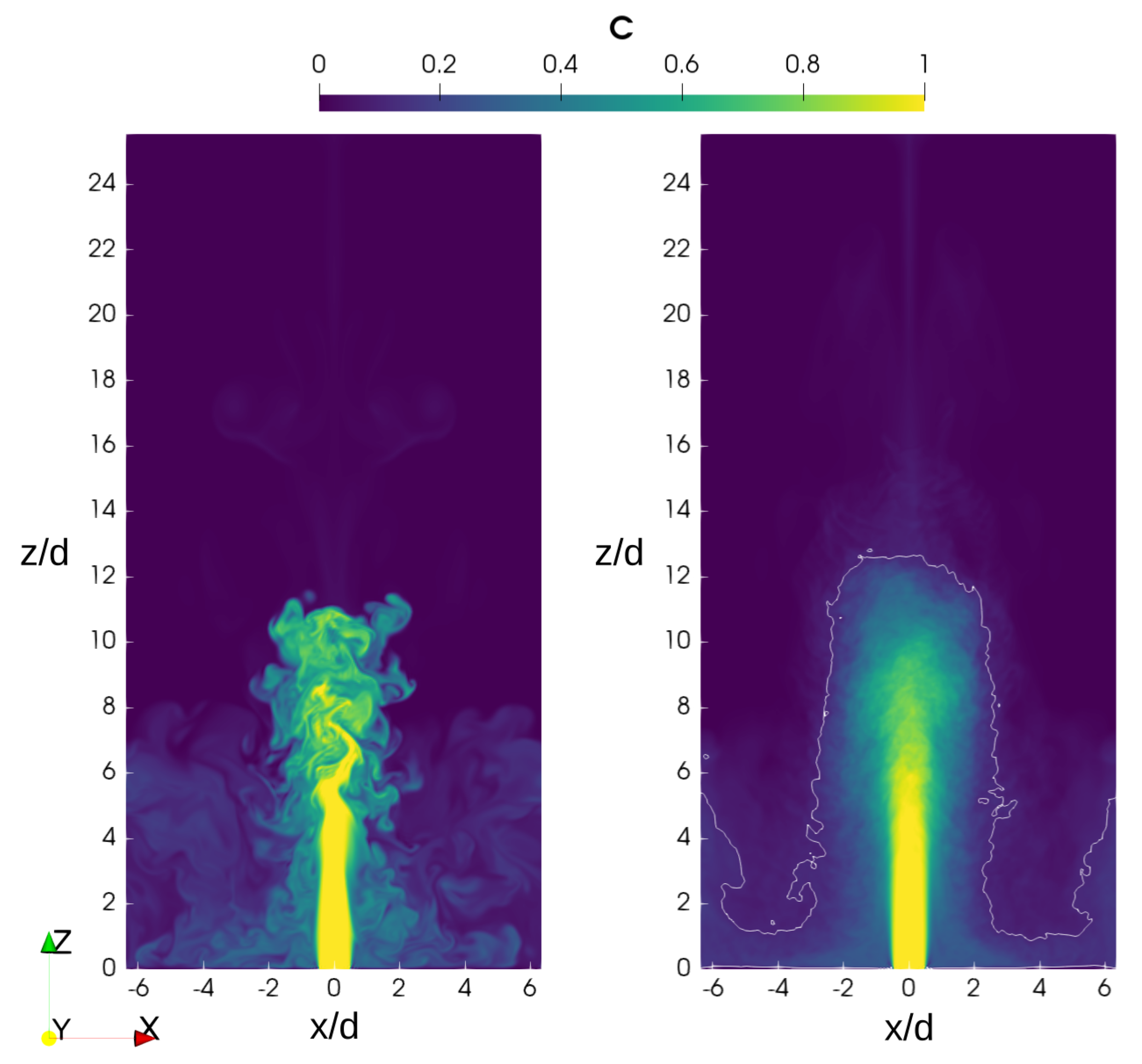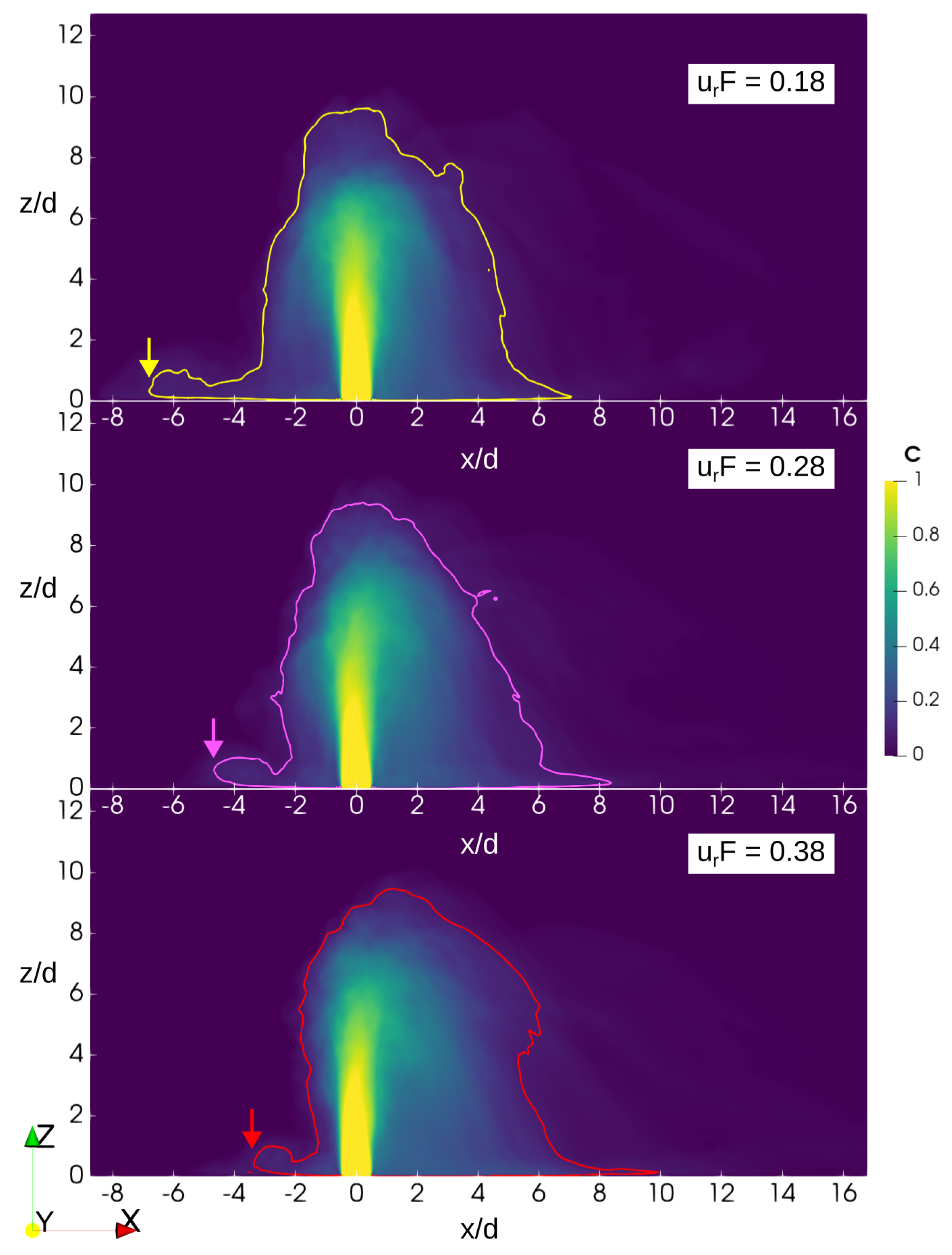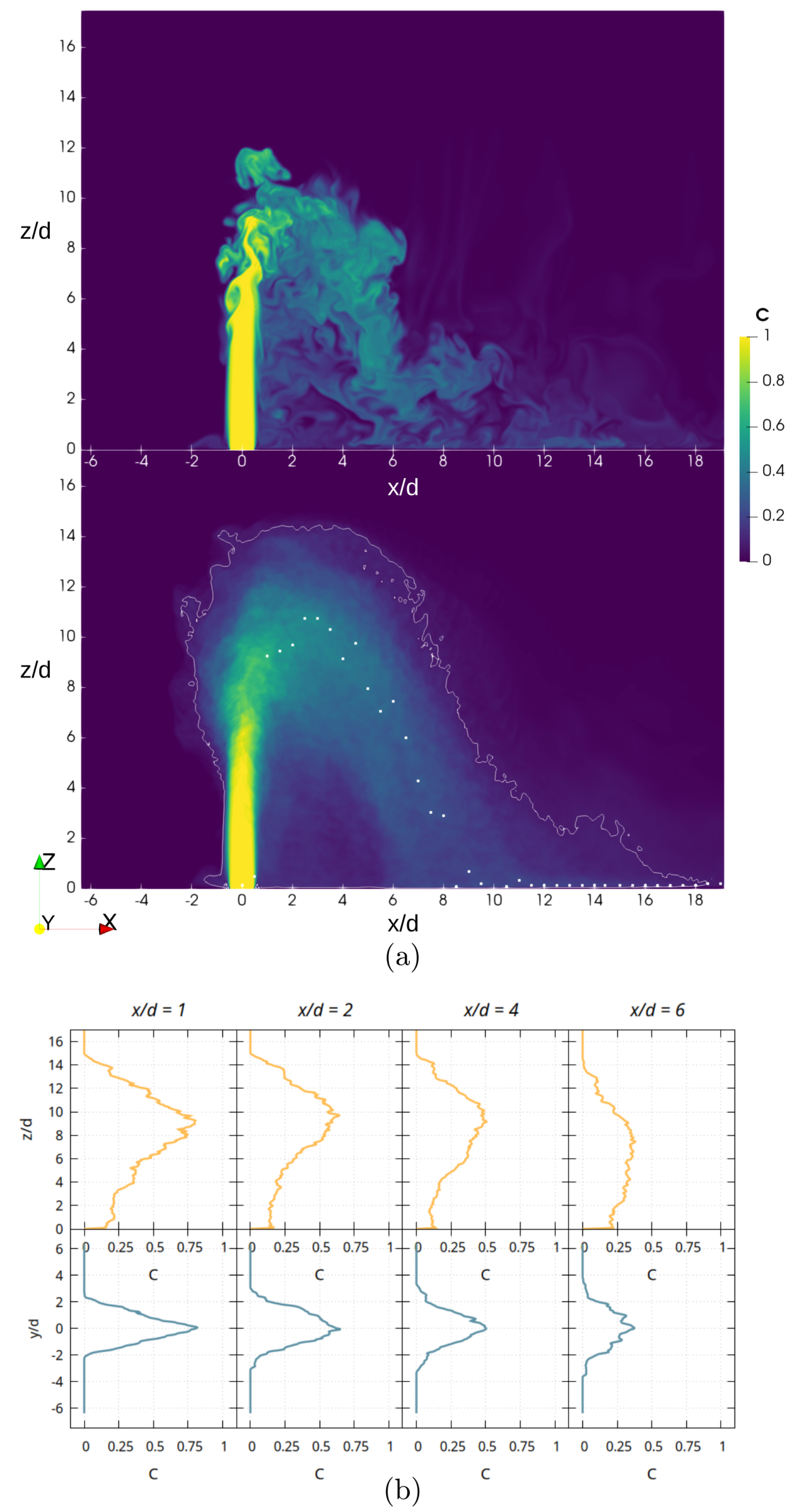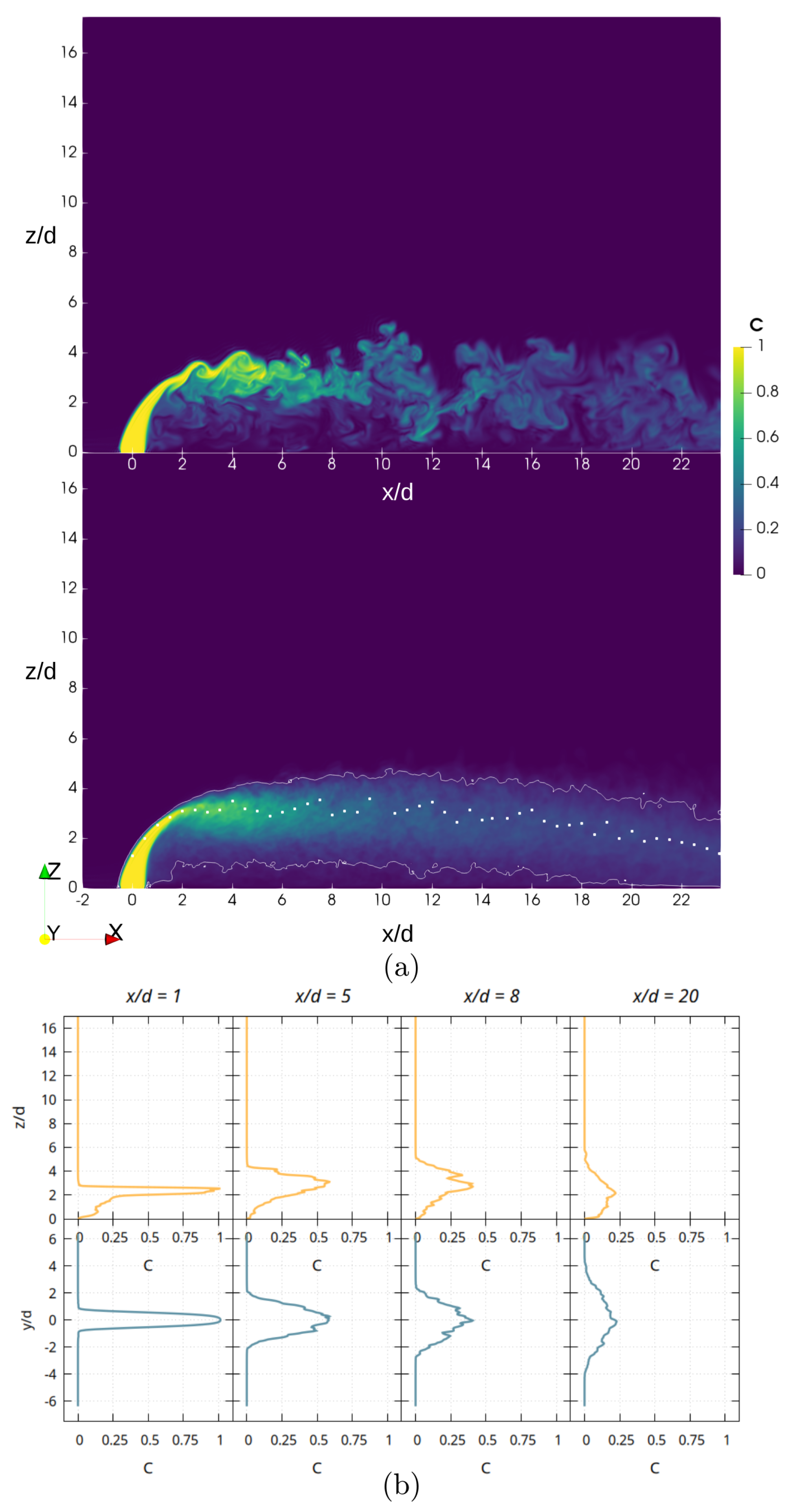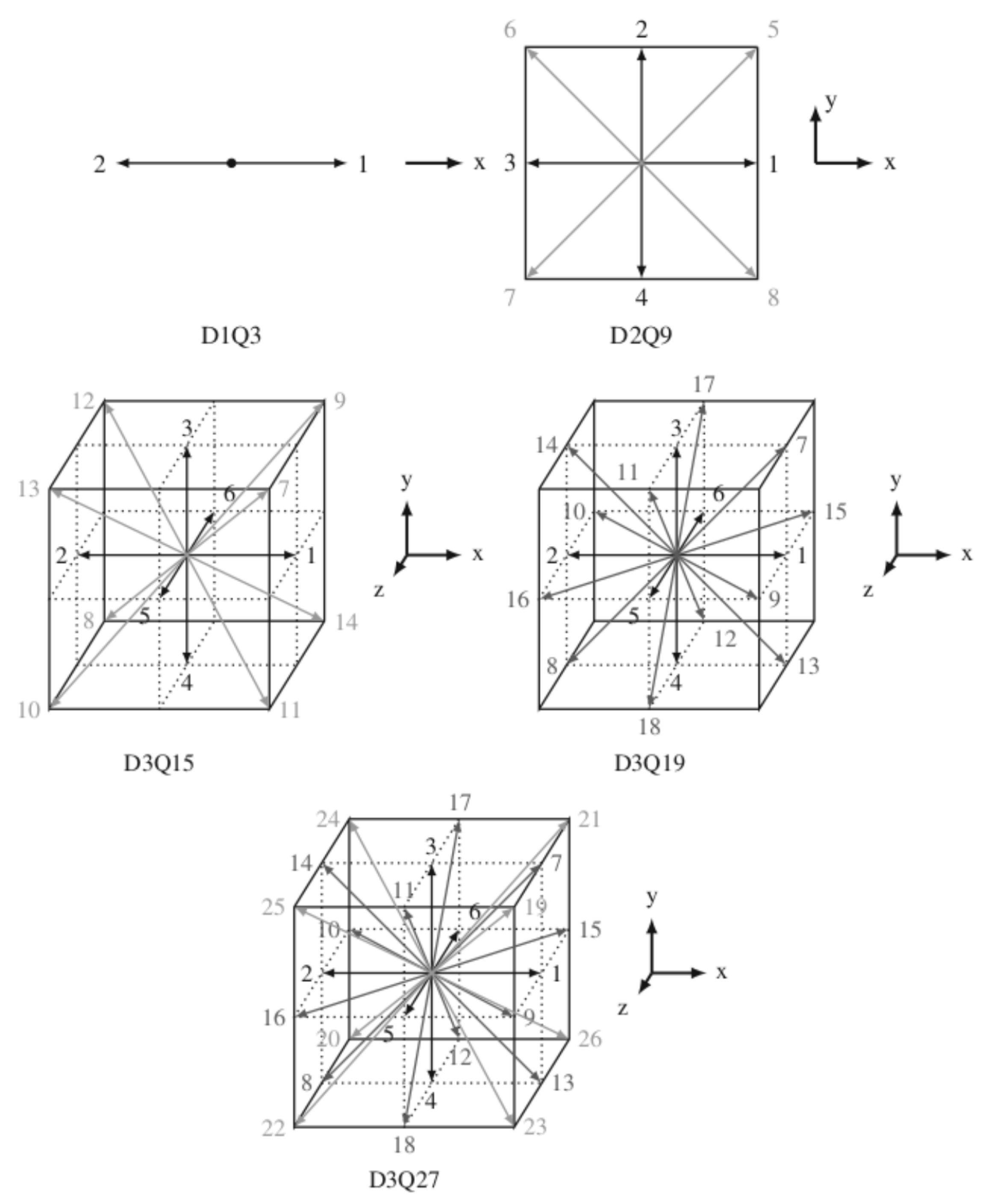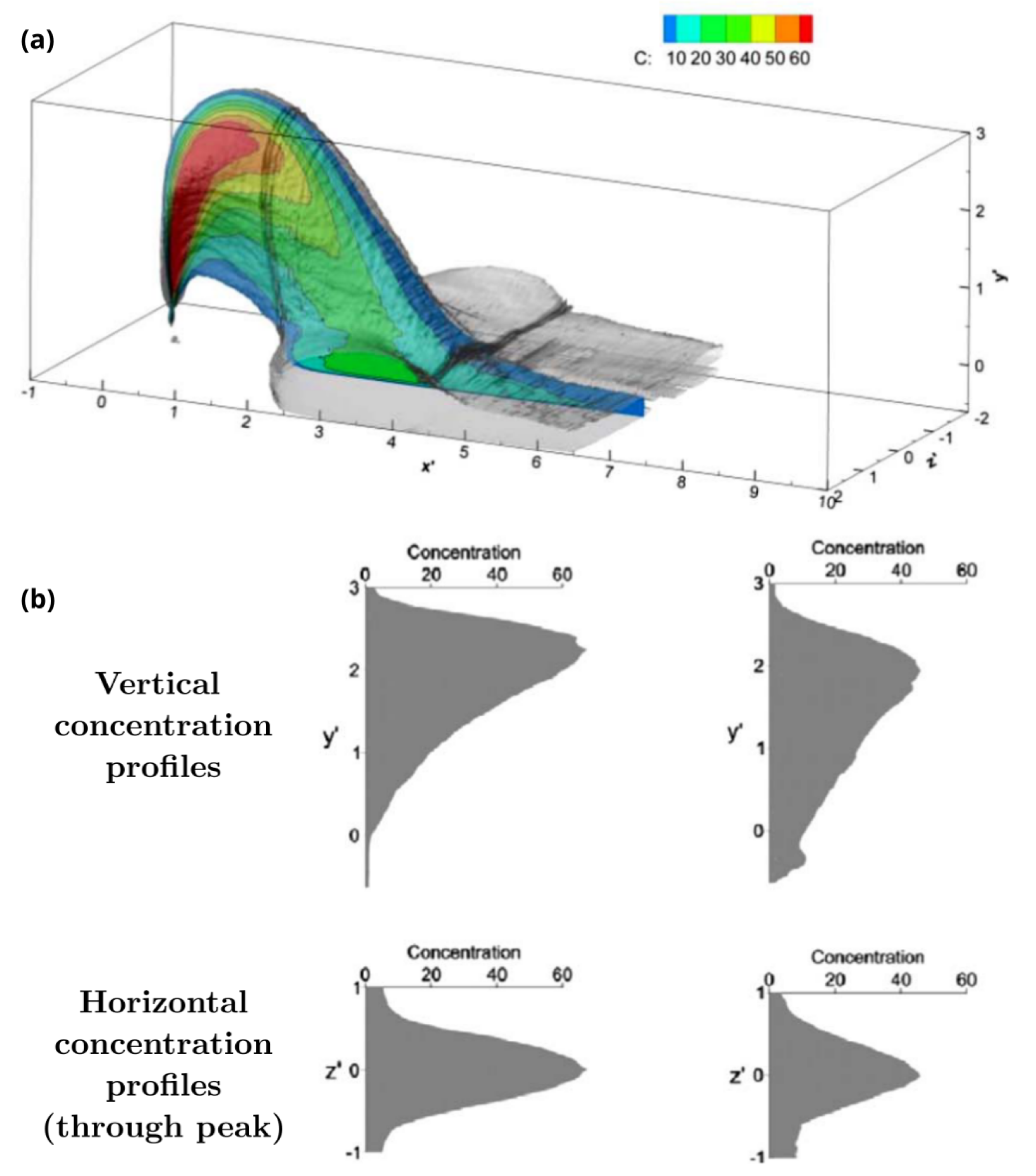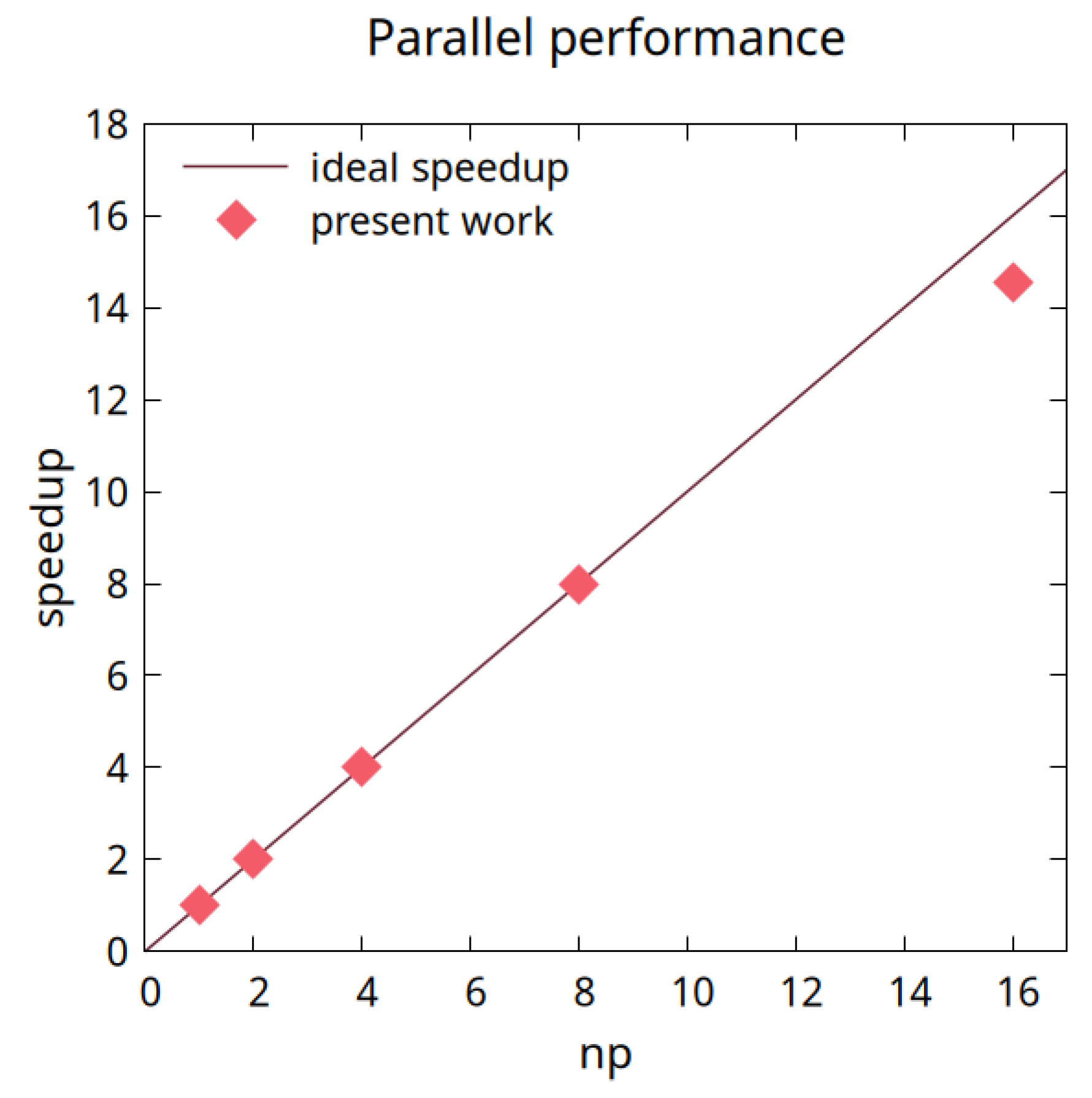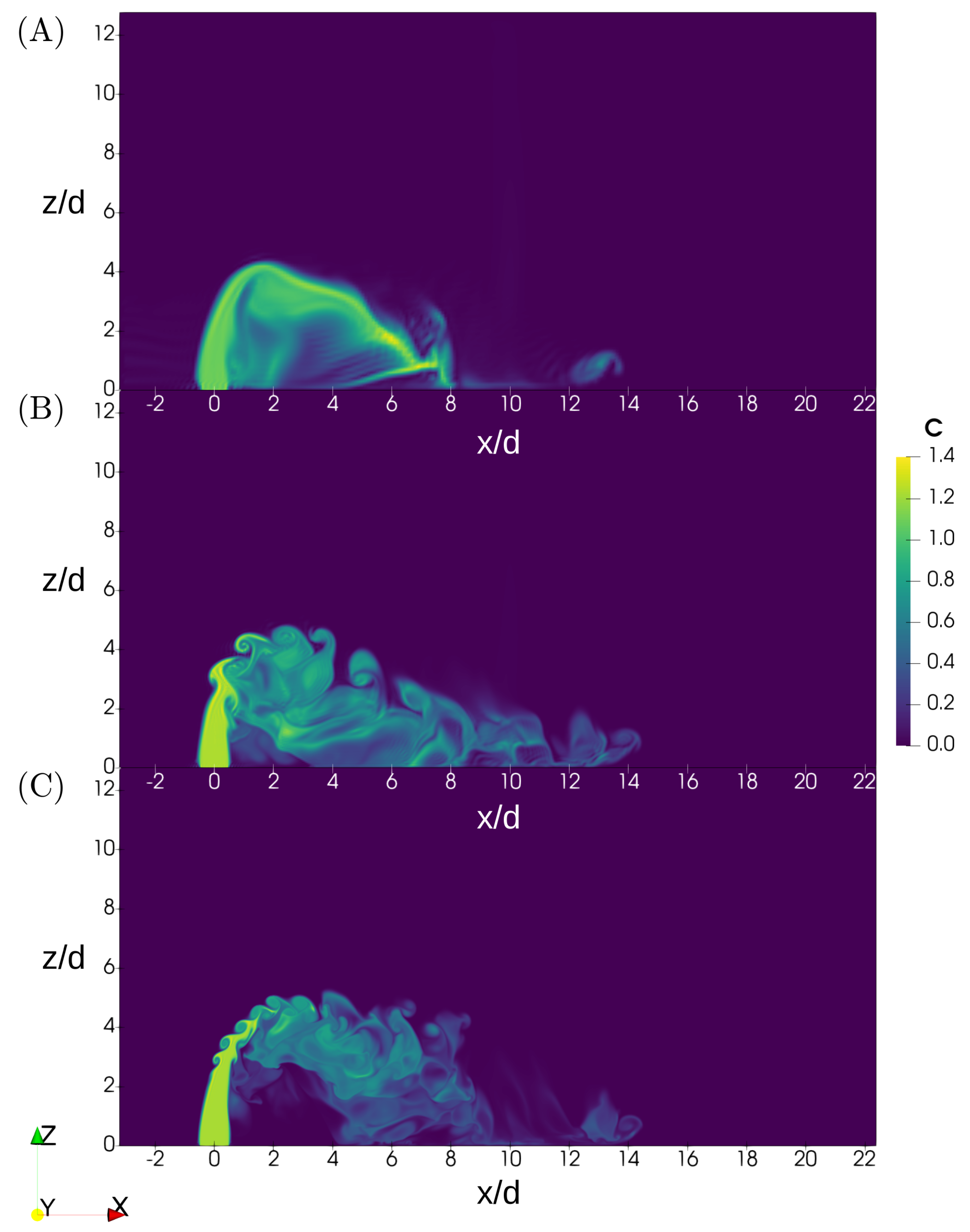1. Introduction
The rapid global growth in population and industrial activities has significantly increased the discharge of wastewater into natural water bodies, causing detrimental effects on aquatic ecosystems and human reliance on water for drinking, recreation, and economic activities, as well as increasing the potential for health risks [
1,
2]. Among the main sources of these discharges are desalination plants, which can harm marine life and disrupt the delicate balance in aquatic ecosystems. Effective management of coastal water quality requires the design of efficient wastewater outfall systems, which, in turn, depends on the study of pollutant dispersion and dilution. In fact, this implies understanding the characteristics of jets in crossflows (JICF)—streams of effluent discharged into a non-stagnant receiving ambient flow.
Studies focusing on JICF are very diverse in scope, as they represent a key fluid dynamics problem with numerous applications, particularly in aerodynamics and flow control: recent advances have demonstrated the effectiveness of pulsed JICF for controlling flow separation on airfoils [
3] and for modulating momentum and frequency to enhance aerodynamic performance [
4,
5]. JICF also plays a prominent role in film cooling for gas turbine blades and fuel atomization in scramjets [
6]. General overviews on JICF dynamics and supersonic jet injection into the water further underscore the wide relevance of this topic [
7,
8,
9].
In the context of wastewater outfalls, JICFs are crucial in the dilution and dispersion of pollutants. Density differences between the effluent and the receiving water body are often involved, such as in the case of discharges of heated cooling water from power plants (positively buoyant jet) or brine from desalination plants (negatively buoyant jet) [
10,
11].
The mixing of effluents and characteristics of JICF can be investigated both through experimental and numerical means. Among the latter, Computational Fluid Dynamics (CFD) methods based on the discretization of the Navier–Stokes (NS) equations have been widely applied to simulate pollutant dispersion [
12,
13,
14,
15,
16], thanks to advancements in technology and the availability of computational power. These approaches, however, often prove to be resource-intensive; thus, it is important to take full advantage of multi-core processors in boosting performance through parallel computations. The advent of High-Performance Computing (HPC) and multi-core architectures has encouraged the exploration of more efficient approaches, increasing performance and avoiding potential bottlenecks that can hinder the advantages of parallel execution. In this regard, Lattice Boltzmann Methods (LBM) are particularly well-suited, as the algorithm they employ is based on discretizing the Boltzmann equation rather than the traditional NS equation. This characteristic offers several advantages, chief among them a reduced communication footprint between processes, which is a major factor in fully harnessing the benefits of parallelization [
17]. This is a key aspect in a post-exascale world, where numerical applications can leverage a vast number of processing units. For this reason, researchers from a wide range of disciplines involving fluid dynamics have begun exploring the range of applicability of LBM. Several studies have been conducted in the field of microfluidics [
18], as well as in active fluids [
19]. In general, LBM has evolved to tackle several problems, such as multiphase flows, with the color gradient method being successfully applied to simulate complex two-phase systems [
20] and extensions incorporating heat transfer phenomena, further broadening its scope [
21]. Comprehensive reviews highlight the growing multidisciplinary applications of LBM, including its use in acoustics [
22] and nuclear engineering [
23] and advection-diffusion models such as Mason–Weaver for sedimentation studies [
24].
LBM has also been successfully employed to study turbulent jets in a quiescent ambient fluid [
25] as well as in the presence of a crossflow [
26] and in several applications focused on the dispersion and mixing of pollutants. LBM has been adopted alongside shallow water equations to solve the two-dimensional transport of pollutants in tidal flows [
27], and in conjunction with lattice automata to investigate the diffusion of pollutants in vegetated open channels [
28]. Moreover, Large Eddy Simulations (LES) within the framework of LBM have frequently been used to investigate the dispersion of pollutants such as CO from a vehicle exhaust [
29], pollutants in ventilated rooms [
30], in scenarios involving an ongoing evacuation [
31], and on a larger scale in urban environments [
32,
33]. Despite this, no specific attempts to simulate the three-dimensional near-field dispersion of wastewater in ambient water appear to have been carried out, to the authors’ knowledge.
The present study aims to assess the potential of Lattice Boltzmann Methods for simulating vertical negatively buoyant jets in crossflows, representing a fundamental scenario for wastewater outfall analysis. This preliminary work provides a foundation for future large-scale environmental simulations leveraging LBM’s parallel efficiency.
The paper is organized as follows:
Section 2 presents the theoretical background and algorithmic components of the LBM framework.
Section 3 reviews key concepts of negatively buoyant jets in crossflows.
Section 4 describes the computational domain, numerical setup, and boundary conditions.
Section 5 discusses the numerical results and their comparison with expected physical behavior. Finally,
Section 6 concludes the study with remarks and future directions.
2. Lattice Boltzmann Methods
The LBM is based on a mesoscopic approach and relies on solving a discretized version of the Boltzmann equation,
where
is the density function representing the probability of finding a particle at position
and time
t with a velocity
, and
is the lattice timestep. The right-hand side of the equation contains a collision operator,
, which can assume different forms. The index
i refers to the discrete directions in which the particle can move, which depends on the type of lattice considered for the simulation. Some examples of the most commonly used lattices, such as D2Q9, D3Q19, and D3Q27, are shown in
Figure 1, and the choice depends on the characteristics, dimensionality, and symmetries of the problem that one wants to study.
The link between LBM and NS can be found through a multiscale Chapman–Enskog analysis, which involves expressing the populations as a perturbative series centered on the equilibrium density function
,
separating the equilibrium from the nonequilibrium part, where
is a smallness parameter. It is possible to show that NS equations are recovered from the solution of Equation (
1), and macroscopic quantities such as flow density
and velocity
are recovered as moments of the populations,
One of the most common and simple forms for the collision operator is
referred to as the Bhatnagar–Gross–Krook (BGK) operator. It consists of performing the relaxation of the density functions (henceforth called ‘populations’) towards equilibrium,
;
is the relaxation time and is linked to the viscosity of the fluid as
where
is called the speed of sound and for most types of lattices is equal to
. The equilibrium populations are obtained from
where
are weights specific to the chosen velocity set. Substituting Equation (
4) into Equation (
1), one obtains the so-called LBGK equation.
The core of the LBM algorithm can be split into two steps, collision and streaming, which are the main reasons behind LBM’s peculiarities. The collision step, corresponding to the right-hand side of Equation (
1), is non-linear but local, as it does not require information from neighboring nodes. The opposite can be said about the streaming operation, corresponding to the left-hand side of Equation (
1), which is non-local but linear. This is the key property that makes LBM extremely well-suited for high-performance computing on parallel architectures.
The phenomenon to be studied—brine diffusion from outfalls—also deals with the presence of a concentration field, making it necessary to model its presence and evolution. In order to do this, an Advection Diffusion Equation (ADE) must also be solved; due to the similarities between the ADE and the NS equation, it is possible to employ a similar approach to the one described above. The equation to be tackled is
where
C is a scalar field such as temperature or concentration,
q is a source/sink term, which is set to zero in this study, and
D is the diffusion coefficient. To solve the ADE with an LBM-based approach, a second set of populations,
, is introduced, which will evolve according to an equation analogous to Equation (
1),
Here,
and
are the relaxation time and the equilibrium distributions for the set of populations
, respectively. The former is linked to the diffusion coefficient in the ADE via the relation
while the latter can be expressed as
where once again, the speed of sound
and the weights
depend on the chosen velocity set. The concentration
C can be recovered as the zero-th-order moment of the new set of populations,
As well as the presence of a saline concentration field, the effect of gravity must also be taken into account. In this study, the difference between the jet density
and the ambient fluid density
is assumed to be small, so the Boussinesq approximation is valid, and the density variations can be assumed to affect the flow only via the gravity force term, keeping the incompressibility hypothesis. Thus, the force term considered
is equal to
where
is the unit vector aligned with the vertical direction, designated by the
Z axis;
is the density of the salt; and
is the salt concentration at point
and at time
t. There are several possible strategies to add a body force to the simulation; in this work, the one developed by Guo [
35] is employed, which relies on adding terms related to the force both in the expression for the velocity Equation (3b) and in the LBGK equation.
Simulations of turbulent flows often require the use of turbulence models to reduce computational costs while retaining essential flow features. In this study, an LES approach integrated into the LBM framework was adopted, following the implementation described by Hou [
36]. Specifically, the widely used Smagorinsky subgrid-scale model was employed. It should be noted that this model is known to have limitations in accurately representing turbulence in strongly stratified flows [
37,
38]. This limitation is particularly relevant for low-Froude number dense jets, where buoyancy and stable density gradients can significantly influence turbulence generation and suppression. Moreover, the Smagorinsky model may introduce excessive eddy viscosity in transitional or low-Reynolds number regimes, potentially dampening the development of resolved turbulence. However, this model was chosen for the present work due to its simplicity and its straightforward implementation in the framework of LBM.
The Smagorinsky model relies on a filtering operation, and the unresolved scales of turbulence are modeled through the introduction of a turbulent viscosity,
,
where
is the Smagorinsky constant, which is a numerical quantity typically in the range
,
is the filter width, and
is the components of the strain rate tensor, which can be obtained through the non-equilibrium populations. In this work, the filter width
is taken equal to the local grid spacing, which is a common practice in LES [
39,
40]. The total effective viscosity is thus obtained by adding the kinematic and turbulent viscosity
; in turn, the effective relaxation time—which is linked to viscosity—will also be expressed as the sum of two terms,
.
When certain quantities exhibit rapid variations in both time and space, as in the case of turbulent flows, numerical instabilities may arise. In order to mitigate this, a recursive regularization procedure, first presented by [
41] and improved by [
42], can be applied to the collision operator. At a given iteration, the macroscopic observables—computed in the previous iteration—are used to obtain an approximation of the non-equilibrium part of the population, which is summed to the equilibrium part. Afterwards, the standard BGK operator is applied.
3. Negatively Buoyant Jets in Crossflows
The phenomenon under consideration is that of a vertical saline—and thus, dense—jet of density
released with a velocity
from a nozzle of diameter
d into a receiving fluid of density
, with an ambient crossflow velocity
. A relevant quantity for describing jet behavior is the densimetric Froude number, defined as
where
is the initial value of the modified acceleration due to gravity,
g. This quantity connects the inertial forces to the buoyancy forces in plumes and is a measure of the importance of the source volume flux.
Because vertical jets fall back directly onto themselves when discharged into a stationary environment, thereby impairing dilution, diffusers are frequently designed with the nozzle inclined at some oblique angle to the horizontal [
43]. However, vertical jets do not collapse onto themselves in the presence of even a moderate current and can be more advantageous in specific situations, such as when the current’s direction changes or fluctuates, which is typical of tidal regimes. Gungor and Roberts [
44] observed that the dynamical effect of the ambient current is mainly determined by the so-called crossflow parameter,
which does not depend on the jet velocity
.
As illustrated in
Figure 2, the behavior of the negatively buoyant JICF is strongly dependent on the value of
. In the absence of a crossflow, the jet falls back on itself, similar to a fountain, and spreads on the bottom as a density current. However, as soon as
, the trajectory of the jet bends in the direction of the ambient flow. It is observed that the jet trajectory reaches a maximum height for values of the crossflow parameter around 0.2 and 0.8, and for
, the bottom layer of the jet forms an upstream wedge, whose length decreases as the value of
approaches 0.5, as can be inferred from
Figure 2 and
Figure 3a.
It can be deduced that, for
, the current does not significantly affect the jet, which rapidly rises and then falls not very far from the jet nozzle. When
becomes approximately equal to 1, this behavior changes, and the descending phase becomes much more gradual while the jet trajectory reaches a lower maximum height. It can be seen from
Figure 3b that vertical concentration profiles are especially asymmetrical in the ascending phase due to gravitational instabilities. The horizontal concentration profiles through the peak, on the other hand, are symmetric in both phases. The asymmetry of the vertical concentration profiles will also be less pronounced in the descending phase for jets with
and beyond.
Generally, the jets with a greater ability to diffuse are those with a crossflow parameter . This is due to the fact that, as their trajectory is almost horizontal, they are able to travel across a longer distance before impacting the floor, and they end up being dispersed by ambient turbulence in the receiving waters or being trapped in ambient density stratification, minimizing the impact of the jet fluid on the seabed. This is of particular importance, as the benthic community has limited mobility and is presumably most vulnerable to increased salinity on the sea floor.
Jet trajectories can be defined in a number of ways, and different approaches for their calculation have been followed in the literature. Some are based on velocity maxima [
45], while others employ maxima from either the concentration of a passive scalar or from a temperature field [
46], sometimes differentiating the two by calling the concentration-based one centerline.
In this work, the jet trajectory of a vertical dense JICF is defined as the curve formed by the locus of maximum saline concentration at the different downstream positions
, along the axisymmetric plane corresponding to
, following the definition used by Ben Meftah and Mossa [
47]. From the jet trajectory, the terminal rise height and impact distance can be extracted. The terminal rise height
, which is the maximum height the jet reaches along its trajectory, can be expressed with semi-empirical relations derived by Roberts and Toms [
48]:
From these relations, it is evident that the terminal height reached by a jet is expected to roughly depend solely on its values of
and, for jets in a stronger ambient crossflow,
F. The impact distance
is the downstream distance at which the jet impacts the bottom of the channel, for which Gungor and Roberts [
44] derived the relation
Having defined the dilution at a point as
, where
is the saline concentration at the jet nozzle, and
is the ambient saline concentration, Roberts and Toms also introduced semi-empirical power law equations for
, the dilution at the terminal rise height, and
, the dilution at the impact point on the bottom of the channel.
As outlined by Fric and Roshko [
49], four fundamental vertical structures are present in a JICF:
A horseshoe vortex forming upstream of the jet exit;
Jet shear-layer ring vortices, generated at the windward interface between the jet and the crossflow;
Unsteady wake vortices beneath the detached jet;
A counter-rotating vortex pair (CRVP).
All these structures, illustrated in
Figure 4, are intertwined as they originate and are affected by the interaction between the crossflow and the jet flow. For a negatively buoyant JICF, it was noted [
44,
50] that the presence of a CRVP in their flow field emerges in jets whose crossflow parameter is greater than 1.0. This reinforces the statement that negatively buoyant JICF with a higher crossflow parameter tends to have a lower environmental impact, as the CRVP is linked to the mixing of ambient water with the jet fluid in a process called entrainment, where ambient fluid is incorporated in the jet core through “gulps” caused by vortical structures.
4. Numerical Implementation
To conduct the simulations discussed in the following section, a full-LBM-based approach was adopted to solve both the NS equation and the ADE, as described in
Section 2. A D3Q27 velocity set (shown in
Figure 1) was chosen to solve the hydrodynamics of the system, as it is more appropriate for simulating turbulent flows for isotropy-related reasons, while a D3Q7 lattice was employed for the ADE: it has been shown, in fact, that this type of lattice is sufficient for most diffusion problems [
51]. Although anisotropic turbulent diffusion can be relevant in environmental flows, acceptable results can still be obtained by approximating both the diffusion and the eddy viscosity as isotropic [
52]. Therefore, this approximation was adopted here for simplicity. As the flows subject to the present study were expected to be turbulent, LES was integrated in the LBM framework, following the procedure detailed above and employing the Smagorinsky model.
In order to achieve greater numerical stability, the recursive regularization procedure for the collision operator procedure was also carried out. The code employed was developed entirely in-house, in C/C++ language. It was parallel and made use of Message Passing Interface (MPI) libraries for handling communications between different threads.
Figure 5 illustrates the speedup (the ratio of the time required to complete a simulation with one MPI process to the time required to complete the same simulation with
np MPI processes) of the code for up to
.
In order to describe the behavior of a vertical dense jet in the presence of an ambient crossflow, the computational domain considered had a cuboid shape to take into account the bending over of the jet in the direction of the crossflow. Specifically, a ratio of 2:1:1 was kept for the length of the system in directions X, Y, and Z, respectively. Unless otherwise specified, the computational grid employed a discretization of 512 points in the streamwise direction (X) and 256 points in the other two directions (Y, Z). The presence of the crossflow was implemented through open boundaries in the streamwise direction X, specifically an inlet where the flow velocity was imposed and an outlet where pressure (density) values were specified. This allowed the flow in the bulk of the domain to be kept at a constant velocity in the absence of the jet. On the floor, which was modeled with a no-slip wall, a round jet inlet was positioned with an imposed uniform velocity profile. The diameter of the nozzle was discretized with 20 grid points and placed at 12.8 diameters downstream of the channel inlet, in the middle of the channel in the Y direction. The top wall was modeled either as a free-slip or as a moving wall with the same velocity imposed in the channel. In the Y direction, periodic boundary conditions were considered, which can be interpreted as a way to model the presence of multiple jets with a spacing equal to the size of the domain in the direction transverse to the ambient flow. A more in-depth description of the boundary conditions employed is given in the following paragraph.
4.1. Boundary Conditions
Boundary nodes in LBM typically require special treatment, as populations streaming inside the domain from boundary nodes are not defined. In this study, the bottom wall of the computational domain was implemented as a simple bounce-back boundary condition based on the idea that populations hitting a rigid wall during propagation are reflected back to where they came from. In order to implement this procedure, one considers that populations leaving the boundary node
at time
t meet the wall surface at time
, where they are reflected back with a velocity
and arrive at time
back at the node
where they came from. For these populations, the streaming step is replaced by
While the basic bounce-back principle is used to model stationary walls, the idea behind it can be used to also implement boundary conditions for moving walls. In this case, assuming the wall has a velocity
, the bounce-back procedure prescribes
where
is the density at the wall, which can be extrapolated from the nearest fluid boundary.
Free-slip-type boundaries, which enforce a zero normal fluid velocity
but place no restrictions on the tangential fluid velocity
, are implemented with a slight variation on the bounce-back method. Populations leaving a boundary node
at time
t that meet the free-slip surface at time
are reflected specularly, and then they arrive at the node
or one of the neighboring ones at time
. The standard streaming step for these populations is replaced by
where
is the tangential velocity of the populations, equalling
and
with their normal velocity set to zero.
The inlet and outlet were obtained as regularized boundary conditions. As the name suggests, they are related to the regularization procedure discussed at the end of
Section 2 and specifically to the procedure introduced by Latt and Chopard in [
41] and detailed in [
53]. It is based on evaluating the non-equilibrium part of the populations based on the knowledge of the populations already known and then reconstructing the missing particle populations in a way that is consistent with the multiscale analysis.
4.2. Domain Size
Given the exploratory nature of this study, aimed at evaluating the potential of the LBM framework to model the behavior of a saline jet in an ambient current, some consideration was made to employ a balanced approach in selecting an appropriate grid size for the simulations presented in the following section.
Some tests were performed on a jet with
in order to compare the simulation results of a specific vertical dense JCIF using three differently sized computational domains. Specifically, the behavior of the same vertical dense JICF, with
(
,
, and
), was investigated by running simulations with a domain with a discretization along directions X, Y, and Z, of
points (A),
points (B), and
points (C).
Figure 6 shows the comparison of the instantaneous concentration field in the axisymmetric plane after the same amount of iteration has been carried out in all three cases, each with its own time discretization.
Figure 7 compares the streamlines in simulations (A), (B), and (C). It can be seen that for smaller grids, there is a relevant loss of resolution in the vortical structures that appear in the flow, as can be expected. Specifically, the velocity streamlines in simulation (A) highlight that the CRVP is pretty much absent, and the flow in the domain is almost laminar.
Ring vortices are completely absent in this case as well, as can be inferred by both
Figure 6 and
Figure 7, which also indicate the ability of simulations performed with grid size (B) to correctly describe the formation of vortical structures such as CRVP, ring, and wake vortices, as discussed in more detail in
Section 3. The computational domain for simulation (C) seems even more richly populated by turbulent structures, as would be expected from more finely discretized grids.
Despite these differences, the general behavior is consistent throughout the three cases considered. The terminal rise height is roughly the same, and so is the location of the impact with the bottom of the channel, as can be inferred from
Figure 6. Due to the jet showing a less turbulent behavior for the lowest resolution grid, the dilution is likely to be underestimated compared with finer grids. Simulation (A) also displays odd values in the concentration map shown in
Figure 6: these unphysical values are linked to the insufficient discretization employed, which renders the results inaccurate. Simulations (B) and (C) show better performances in this regard, as the concentration maps relative to these cases display reasonable behavior. In light of this, the medium-sized grid (B) has been deemed to be a reasonable compromise for the scope of this work, as it was still able to capture vortical structures of the JICF with a reduced computational cost.
All the results of the simulations discussed in the following will be presented as dimensionless quantities. Unit conversion between real units and simulation units can be carried out through dimensionless numbers (such as , , F...) and by observing that flows obeying the NS equation are equivalent if they are described by the same dimensionless quantities and the same geometry.
6. Conclusions
This work detailed the simulation efforts using an in-house code based on a full-LBM approach to explore the evolution of vertical dense jets, including their vertical and horizontal concentration profiles, the formation of vortical structures, and the measurement of relevant quantities such as terminal rise height, impact distance, dilution at terminal rise height, and dilution at impact point. These simulations showed a promising level of agreement in terms of expected qualitative behavior derived from experimental observations. The numerical results for relevant quantities were systematically underestimated, although the key trends were correctly identified, and the formation of three of the four fundamental vortical structures of JICF was successfully captured, with the exception of the horseshoe vortex. The results indicate a good foundation for using the LBM approach in capturing the complex dynamics of JICF. In a post-exascale world, where supercomputers are able to perform near or above floating point operations per second, algorithm scalability is a fundamental asset. Because of this, LBM’s role in HPC applications is becoming more and more prominent. In this context, the findings of this preliminary work confirm it would be worthwhile to further investigate this method’s applicability as a tool to assess the environmental impact of wastewater diffusion in surface water bodies.
The next fundamental steps to improve LBM simulations of vertical dense JICF include implementing mesh refinement strategies, which would enable simulating larger computational domains at reasonable computational cost while allowing for finer grids close to the jet inlet. In addition, employing dynamic subgrid-scale models such as the ones proposed by Germano and Lilly [
55,
56] may mitigate the limitations of Smagorinsky for transitional or low-Reynolds number regimes. Finally, including a turbulent inflow for the jet inlet might improve jet entrainment and structure, leading to more accurate predictions of dilution. Going forward, it would be valuable to conduct a more extensive comparison between numerical results and experimental data, considering vertical and horizontal profiles of velocity and concentration and turbulent quantities, to assess the accuracy of the simulations and further consolidate LBM as a reliable and robust tool for studying brine outfall dispersion.
